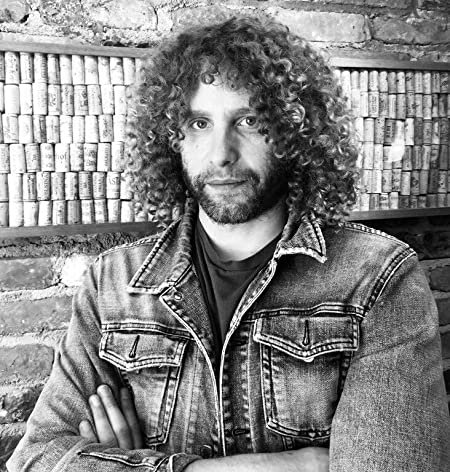Jason Richardson: “I was a high-school kid watching John Petrucci play his Music Man... now I have my own signature model”
The All That Remains prodigy details the development of his Ernie Ball Cutlass seven-string

Anyone who has caught Jason Richardson live with metalcore heroes All That Remains on their recent tour likely witnessed the 27-year-old wunderkind shredding away on an Ernie Ball Music Man seven-string. Which, in and of itself, is not unusual - Richardson has been a longtime champion of EBMM’s extended-range electric guitars.
But upon closer inspection, these fans may have also noticed that this Music Man was unlike any other that Richardson - or any guitarist, for that matter - had ever played before. That’s because this guitar was Richardson’s new Artist Series signature model, which he developed in collaboration with the Ernie Ball Music Man team.
“I use this guitar onstage every night,” Richardson says of the axe, which is based on EBMM’s Cutlass design.
I feel like anyone who picks up this guitar would probably be stoked on it immediately
Jason Richardson
“It’s a gorgeous, gorgeous instrument,” he continues. “I feel like anyone who picks up this guitar would probably be stoked on it immediately, just because of the looks and the feel of the neck and the way it sounds. It’s incredible.”
While Richardson might be a bit biased, given the fact that his name is on the backplate (indeed, he admits with a laugh, this is one of his favorite things about the instrument), the fact remains that his signature model is an impressive guitar, with a lightweight alder body, roasted maple neck and ebony fingerboard, custom EBMM humbuckers, all-black hardware and, most strikingly, a beautifully figured buckeye burl top.
“I’ve been obsessed with buckeye burl since the first time I ever saw the wood,” Richardson says. “Then, in about 2014, Ernie Ball made me a one-off custom JP15 with a buckeye burl top, which was the first one I ever owned. When I got that guitar I put it on my stand and didn’t even play it. I would just stare at that top. I thought it was the sickest-looking thing I’d ever seen in my life.”
That JP15 (Richardson, a huge John Petrucci and Dream Theater fan, has played various JP and Majesty Petrucci signature models over the years) may have been his first buckeye burl guitar, but his relationship with Ernie Ball Music Man extends back even further. EBMM’s Sterling Ball recalls first meeting Richardson when he was just 14.
All the latest guitar news, interviews, lessons, reviews, deals and more, direct to your inbox!
“Jason reached out to our artist relations people and we thought he was just great,” Ball says. Since then, Richardson has “earned, grown and played his way” into his current position as an Ernie Ball Music Man signature artist.
“He’s a really crazy-talented kid who became part of the family at a very young age,” Ball continues. “As far as his playing, he has a gift that’s insane. And the pace at which it’s elevated has been spectacular.”

Indeed, over the past few years Richardson has established himself as one of the guitar world’s foremost shredders (not to mention a former Guitar World columnist).
He’s served time with technical metal acts like All Shall Perish, Chelsea Grin and Born of Osiris, guested with rising instrumental prog-pop shredders Polyphia and released several solo recordings, including the 2016 instrumental album I, which featured guest spots from other top-notch shredders, including Jeff Loomis, Nick Johnson and Mark Holcomb.
All of which is to say that Richardson, despite his penchant for performing ridiculously fast and insanely technical feats of fretboard acrobatics with seeming effortlessness, is more than just a modern-day shred demon.
Take the song Hos Down, which, nestled among the many shred passages, also includes “a country, chicken pickin’ type of part and an elevator jazz section,” he says. “In the span of, like, a minute or two, it goes through all these different sounds and styles.”
Which is why Richardson required his Artist Series model to be a versatile instrument, beginning with the shape.
“People think of him more as a metal type of player, but he can do anything,” Ball says. “So he wanted a guitar that you can play all types of music with, and that’s why he wanted a guitar with a Strat-style body shape.”
Then there’s the custom Ernie Ball Music Man pickups, which consist of two seven-string humbuckers that can be split for spanky single-coil tones.
“I wanted a guitar that can switch back and forth between a humbucking configuration and a single-coil one,” Richardson says.
“So the way the switching works is that there’s a three-way toggle, a volume knob and a tone knob with a coil tap. When you engage the coil tap and have the three-way toggle in the up or down position you’re just using the outermost coil of the neck or bridge humbucker.
“But a cool thing we did is that when you put the toggle in the middle position, the guitar immediately goes into coil-split mode, using the two outermost coils of each humbucker, whether or not you have the coil tap engaged.
“You don’t have to also pull up on the tone knob to activate that really bright, shimmery single-coil sound. In a live setting, that’s an extra motion you would need to do to get to that configuration. But I wanted to expedite that a little bit because that’s the sound I very much prefer when it comes to cleans.”
All that said, Richardson’s signature model is well-geared toward straight-up shredding as well. In addition to slimming down the neck a bit from the standard Cutlass design, Richardson and EBMM also removed some mass from the body, and in a very unusual way - by adding an extreme contour to the lower horn, but only on the back of the guitar.
Ernie Ball came up with the idea of shaving down the backside of the bottom horn to get rid of a little bit of weight
Jason Richardson
“The engineering team at Ernie Ball came up with the idea of shaving down the backside of the bottom horn to get rid of a little bit of weight and make some more room for your knuckles when you’re up on the 24th fret,” Richardson says.
“Essentially, the horn tapers down on the back of the body, but not the front. I thought that was a pretty creative idea.”
According to Ball, this was a key customization.
“When you’re designing a guitar for someone who uses every single fret and string, you can’t fake any of the access stuff,” he says.
“If you’re working with more of a roots type of player, that’s an easier guitar to build. But Jason is similar to someone like John Petrucci - these are guys that use every single part of the instrument. The level of precision they have, you have to make sure the guitar doesn’t get in the way.”
Indeed, Ball sees a through-line not only between Richardson and Petrucci, but also with Richardson and all of Ernie’s Ball signature artists, from Steve Morse and Steve Lukather to Annie Clark, aka St. Vincent.
“They’re all immense talents in their own way,” Ball says. “And they’re all true artists. And I always like to say, ‘We make tools for artists.’”
“The thing with Ernie Ball is, it may seem like we’re a big company, but we have very limited production,” he continues.
“We don’t make that many guitars, because there’s only so many guitars we can make at our quality level that supports our price point, so we find our artists, and then we make a commitment to them. I think they’re attracted to our commitment and our support for what they do.”
As for Richardson, at present he’s committed to continuing on with live performance with All That Remains, whom he joined at the end of last year, following the unexpected and tragic death of lead guitarist Oli Herbert.
“The circumstances under which it happened are far from preferable,” Richardson acknowledges. “But you make the best of the situation, and I love playing those songs onstage.”
I can use it for any style of music. It’s pretty much built for anything
Jason Richardson
In addition to touring and, eventually, recording with All That Remains, Richardson is also focused on getting his second solo album written and recorded, and then heading out on the road to play the new material for his growing contingent of fans. And without a doubt, the guitar he’ll be using to get the job done in the studio and onstage is his Artist Series model.
“For sure,” he says. “I’ve done a couple tours with it already, and I can use it for any style of music. It’s pretty much built for anything. I think next year we’re going to do a six-string version as well, just to make it even more accessible.”
Richardson continues. “You know, I never thought something like this would ever be happening. Not that long ago I was a high-school kid learning Dream Theater songs and watching John Petrucci play his signature Music Man. And now it’s 10 years later and I have my own signature model with the company.
“It’s a wild thing to think about and to actually have go down. You put in all the practice and all the hard work for years and years and then it’s like, ‘This is it. I can hold this in my hands.’ It’s definitely surreal.”
As for whether there will be more surreal collaborations to come for Richardson and Ernie Ball Music Man?
“Absolutely,” Ball says, laughing. “He’d better be ready!”
Rich is the co-author of the best-selling Nöthin' But a Good Time: The Uncensored History of the '80s Hard Rock Explosion. He is also a recording and performing musician, and a former editor of Guitar World magazine and executive editor of Guitar Aficionado magazine. He has authored several additional books, among them Kurt Cobain: Montage of Heck, the companion to the documentary of the same name.

